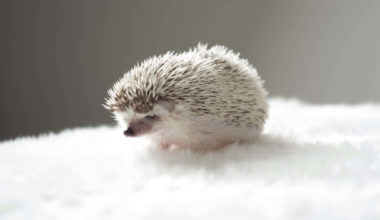Hedgehog hibernation is something that many new pet hedgie owners don’t know much about. Hibernation is a natural thing so it’s nothing to fear, right?
Wrong.
For a domesticated hedgehog, hibernation is potentially fatal.
If this seems a little weird to you right now don’t worry. We’re going to explain domesticated hedgehog hibernation in depth so you know what it is, and what you can do about it.
It’s one of the most important things a pet hedgehog owner should know about.
Why Is Hibernation A Bad Thing?
If a hedgehog isn’t warm enough in their cage there’s a chance that they could go into hibernation. This is a natural instinctive response to lower temperatures. It’s basically ingrained in their behavior since they hibernate when living in the wild.
However, a domesticated African pygmy hedgehog cannot handle the act of hibernation.
This is because of their size and the fact that they don’t have enough fat to make it through a hibernation cycle. Not only does this lack of fat make it harder for them to maintain their temperature, but it means they don’t have enough fuel to sustain them while they hibernate.
As a result, hedgehog hibernation among pet hedgies can lead to serious health complications and even death. While their body does the “right” thing by slowing their heart rate, breaths per minute, and decreasing their temperature, they inevitably can’t handle being in that state.
There are two main problems that arise from this:
- Lack of fuel: Since they don’t have enough fat built up in their body to make it through hibernation, pet hedgehogs will eventually starve and waste away if left in that state.
- They become immunocompromised: Since their metabolic rate drops significantly and their body is consolidating resources as much as possible this can result in a damaged immune system. Not only can this cause issues for the hedgehog while they’re in the process of hibernation, but it can carry over afterword as well and affect their lifespan (assuming you’re able to get them out of it).
How Does This Happen?
Hedgehog hibernation attempts come from one root issue, low temperature in their habitat. Any significant and sustained decrease in room temperature can be all it takes to initiate the process of hibernation.
A lot of breeders and vets use the rule of 68°F is the start of the danger zone. Anything at this temperature or below significantly increases the likelihood that your hedgehog will go into hibernation. They like it toasty!
Note: Check out our new guide on keeping hedgehogs warm, where we make heating lamp and pad recommendations.
However, it’s important to understand that this rule isn’t perfect. Hedgehog hibernation can occur at slightly higher temperatures if the exposure is sustained enough.
That’s why it’s so important for you to keep a close eye on the temperature in your home, and theirs. If you monitor this consistently and effectively you’ll likely never have to worry about this happening to your pet.
Signs & Symptoms
Understanding the signs of a hedgehog hibernation attempt is crucial because you’ll need to act fast to save your hedgie. This section will cover all of the hedgehog hibernation signs to make sure you’re prepared.
One of the most obvious signs of hedgehog hibernation is they might seem a little cool when you touch them. Normally when you touch your hedgie they have plenty of heat, so if that isn’t the case it might be a sign that something is wrong.
You will likely notice a drop in energy as well. This is because their body is starting to conserve energy for their misinformed nap. This is why it’s very helpful to be an engaged owner. Over time you’ll learn the mannerisms and behavior of your hedgie, so when they aren’t acting like themselves it will stand out.
It’s also common for their appetite to be affected as well, even early on. Eventually, this would transition into a total lack of appetite and no interest in eating. This is obviously a big red flag in general, but when combined with some of the other signs in this section it can confirm your suspicions.
You might notice some strange movements on the part of your hedgie. Swaying and wobbling are two things that sometimes accompany hedgehog hibernation. If you notice any of these it’s important to take them seriously because it could indicate wobbly hedgehog syndrome too.
There are some other obvious signs of hedgehog hibernation that you’ll want to look out for. If you notice any shivering or a reluctance to uncurl from their ball you should take it seriously. This could mean they’re cold and in the early stages of hibernation.
What You Can Do
While hedgehog hibernation is a very serious issue, there are some things you can do. The faster you act the better your chances are, so read these closely so you’ll be ready if the time comes.
Treatment
The first thing you’ll want to do is try to raise the temperature of your hedgehog. It’s important to make sure you don’t go overboard here and do it gradually. While your instinct might be to try and warm them up as fast as possible, that can actually cause harm to them as well.
A quick thing you can do is provide body heat for your hedgehog. Take them and put them under your shirt or gently between your legs (if they’re warm). This is an effective strategy for bringing up their temperature without doing it too drastically.
Another method that we’ve heard recommended is to put some towels or cloths in the dryer tick your hedgehog into those. This is another way to quickly fight the effects of hedgehog hibernation with things you have close by.
We like these methods more than cranking up their heating pad because you’re more engaged with the process. You’ll be able to monitor their behavior and temperature a bit easier since you’ll be tending to them directly.
Should You Bring Them To The Vet?
There’s a lot of conflicting information out there about when you should get a vet involved when it comes to hedgehog hibernation. Some resources will even tell you it’s unnecessary if they seem to be returning to normal.
We’re firm believers that even if you see significant progress with bringing their temperature up, you should still take your hedgie to the vet regardless. There are a number of reasons for this.
The first reason is that you can never be entirely sure how much progress has been made until you talk to a vet. They’ll be able to look at the vitals of your hedgehog and see if there is still a cause for concern.
Another reason you’ll want to talk to a vet is to have them look for any other issues that hedgehog hibernation might have caused. We mentioned earlier how their immune system can sometimes become compromised when in this state, so this is something that a good vet will consider.
They’ll probably want to schedule another checkup to monitor progress and recovery. We highly encourage you to do this so you can be confident that there are no underlying issues that could rear their head later on.
Obviously, if your hedgehog has started hibernation and you haven’t seen any improvement after trying to warm them up you should take them to the vet as well.
Quick Note: This is why it’s so important to have a trusted vet who has experience with hedgehogs. A normal vet might not be familiar with hedgehog hibernation.
How To Stop This From Happening
If you’ve gone through a hedgehog hibernation scare or simply want to prevent it from happening to you then this is the section for you. As they say, an ounce of prevention is worth a pound of cure!
Some Likely Causes
There are some causes that trigger hedgehog hibernation far more often than others. Understanding these will help prevent them from cooling down your hedgehog too much.
First, look at the room temperature. If you’re someone who likes to keep things cool then you’ll have to compensate for that with heating solutions in their cage. Not having strong enough heating equipment can lead to the room temperature overpowering the temperature in their cage.
The next thing to look out for is drafts. Some rooms can be draftier than you realize which can send bursts of cold air onto your hedgehog. It might not seem like enough to trigger hibernation, but it doesn’t take much! Address any sources of drafts you find in their room or move them to another part of your home.
Lastly, take a look at your lighting cycles. While heat is usually the primary trigger of hedgehog hibernation, light can play a role as well. Hedgehogs are nocturnal, but they respond to cycles in light just like any other animal. If their room isn’t getting enough light during the daytime it can trick them into thinking it’s time for hibernation. Ideally, you can sort this out with natural lighting but add in some artificial light too if needed.
Putting It All Together
Understanding hedgehog hibernation if you’re an owner is a must if you want to ensure that they live a long and happy life. These little creatures are so susceptible to shifts in temperature that you need to be on guard at all times!
We hope that this knowledge will help take some of the fear out of it. Some new owners spend their days fearing hibernation because they wouldn’t know what to do if it happened. Now that you do, it’s should be a little less unsettling.
Like we said, investing the time and effort to prevent this from happening is always going to be your best course of action. It will be a little extra work initially, but you’ll be happy you did it. It’s the right thing to do for your little hedgie.
If you have any other questions about hedgehog hibernation or ways we can improve this guide we would love to hear from you. Our goal is to be the best hedgehog resource online, and we couldn’t do it without the amazing knowledge of the hedgehog community!






